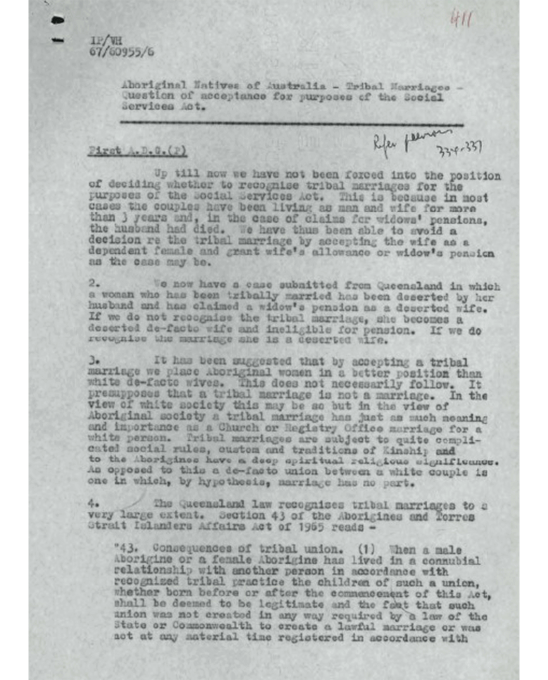
DSS doesn’t recognise Aboriginal marriage practices
In the 1960s, DSS was questioned about their policy of not supporting multiple wives within Aboriginal marriages. They wouldn’t review their policy for years to come.
If we extend pension eligibility to these other wives of Aboriginals it would be difficult to refuse pensions to European women who, innocently or otherwise, enter into bigamous marriages.
| Attachment | Size |
|---|---|
| letters-on-tribal-marriage.pdf | 1.19 MB |
| Attachment | Size |
|---|---|
| letters-on-tribal-marriage-plaintext.docx | 57.5 KB |
Some Aboriginal peoples follow cultural laws around marriage. In the 1960s, government policy was to recognise these marriages in the same way as official state marriages. However, policy didn't account for all aspects of cultural marriage. This included polygamy and so it was difficult for people in polygamous marriages to get payments.
These excerpts contain letters discussing these issues. The letters are between the Minister for Social Services, officials from the Department of Social Services (DSS) and the Director of the Office of Aboriginal Affairs. They give insight into DSS officials’ decision-making in the late 1960s as they considered adjusting policy to take Aboriginal family relationships into account.
A Queensland case in 1967
The letters in the excerpt concern a 1967 case of a family with a first and second wife. The case asks whether a second wife could get government payments that were for married women.
In the initial correspondence, officials wanted to recognise ‘tribal' marriages to avoid being seen as discriminating against cultural practices. In the case of polygamous marriages, it was pointed out that a second wife could be left in a difficult financial position if her circumstances changed.
It was agreed that ‘tribal marriages’ were recognised for the purposes of social security. However, for polygamous marriages, DSS’s policy decision was that only first wives would be recognised as eligible for payments. A second wife would only be able to claim payments in the event of the first wife’s death.
A debate about the policy decision in 1969
Later, in 1969, the Minister for Social Services and Barry Dexter of the Office of Aboriginal Affairs asked questions about DSS’s tribal marriage policy. Dexter advocated for the policy to change.
DSS responded to both questions confirming that second wives couldn’t get payments. It recommended this policy did not change as it was not the intention of social services legislation (Sanders 1987:407).
A later review of the policy in the 1980s
A serious review of how government should consider Aboriginal cultural laws, including recognition of traditional marriages, didn’t occur until the 1980s (Australian Law Reform Commission 1986).
DSS research following this review found that social security policy on marriages with multiple partners was still contested.
This correspondence was kept in a file by the Department of Social Services. The file was later transferred to the National Archives of Australia, which holds it as part of the national archival collection.
You can access the file through RecordSearch. Go to pages 205 to 207 for the original DSS correspondence.
Citation
National Archives of Australia: Department of Social Services; A884, Correspondence files, 1951–74; A2876 Part 3, Social service payment to Aborigines – policy, 1967–1970.
